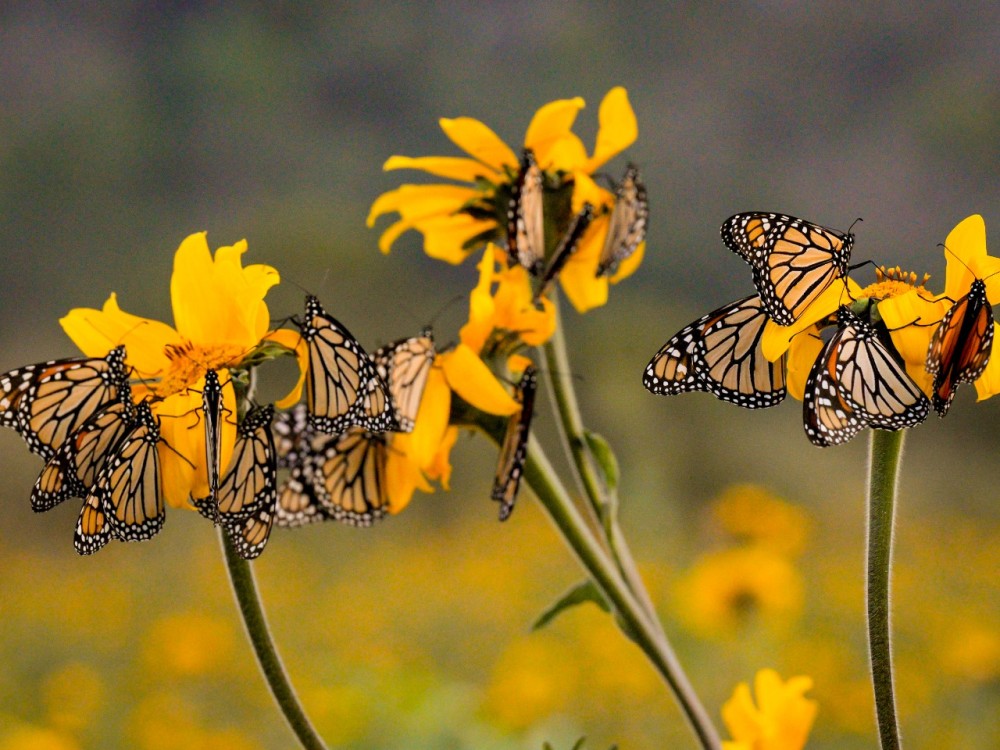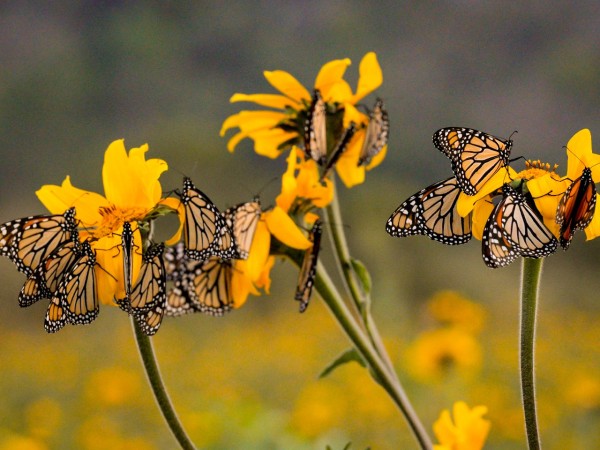Still waiting on more monarchs near overwintering sites
While it's been a couple of weeks since the first monarchs were spotted near overwintering sites in Mexico, monarchs are not yet arriving in droves.
Journey North writer Estela Romero reports from Angangueo that between last Wednesday and Friday, a few groups of monarchs were seen dispersed in areas surrounding the village, heading south to El Rosario or Cerro Pelón sanctuaries.
Dear Friends,
Monarchs arrivals to Cerro Pelón, Sierra Chincua and El Rosario mountains increase as days pass by, step-by-step, day-by-day, but very gradually. It is now possible to see them swinging from their northern arrival up to their final destination at the top of our majestic oyamel forests at over 10,000 feet of elevation.
Numbers are, however, low for this date in November: two here, one further away, seldom four flying close together, so high up and far apart from each other at only certain open and cliff-like areas.
Traditionally, it takes monarchs all of November to recognize and decide their best overwintering spots amidst the woods to begin this phase of their annual cycle. December might be a better time to start planning a visit to either sanctuary.
Both Sierra Chincua and El Rosario sanctuaries will inaugurate the opening of the season on Nov. 15.
Days of permanent alert shall keep us moving around as we observe numbers increasing. We shall keep you all informed, our dear friends from Journey North.
Estela Romero
Journey North
Angangueo, Michoacán, México
Will more show up soon?
At the risk of sounding like a broken record, we continue to receive reports from areas just north of overwintering sites.
Near Monterrey, Nuevo León, Correo Real reported that over 3,000 monarchs had been spotted on Nov. 12, sharing a quote from Elsa Hernandez on Instagram: “Anoche nos sorprendieron las mariposas, no esperábamos ver tantas, y estimamos más de 3,000 en un sólo parque. Hoy por la mañana tuvimos oportunidad de ir a fotografiarlas con luz de día. Siguen pasando por aquí, esperemos continúe el flujo en los próximos días.”
“Last night we were surprised by the butterflies, we did not expect to see so many, and we estimate more than 3,000 in just one park. This morning we had the opportunity to go photograph them in daylight. They continue to pass through here, let's hope the flow continues in the coming days."
We were also tagged in a wonderful video from Linabeth Flores in Cañón de San Lorenzo, Saltillo, Coahuila, with monarchs fluttering all around. Cañón de San Lorenzo is near Monterrey.
Diving into Journey North reports, Armando observed 100 monarchs in Cinco Pinos, Tamaulipas on Nov. 10, writing, “mariposas monarcas perchadas en las flores de parcela entre camino rural y sembradio de maiz, clima fresci medio nublado, en varias flores se percharon las monarcas y en los arboles de alrededor.
Monarch butterflies perched on the flowers of the plot between the rural road and the corn field, cool, partly cloudy weather, the monarchs perched on several flowers and on the surrounding trees.”
Nearby, Armando reported 20 on the same day in La Florida, Tamaulipas.
As the crow flies, Cinco Pinos is about 280 miles from the Monarch Biosphere Reserve and La Florida is about 265.
Gilberto reported 300 monarchs on Nov. 11 in Emeterio Tovar, Guanajuato, less than 40 miles from the reserve's closest border.
It remains to be seen whether this will translate into more monarchs at traditional overwintering sites soon.
Keep your reports coming
We appreciate all of the reports from Mexico over the last few weeks as we anxiously await large groups of monarchs to grace the sanctuaries’ oyamel forests.
Whether you’re in Mexico or still seeing monarchs in the United States or Canada (we received a report from Nova Scotia on Nov. 11), keep sending us your observations! We can’t track their migration without you.
Estela Romero is an environmental educator with Monarchs Across Georgia. Reporting from Angangueo, Michoacán, Estela Romero's work is made possible by funding from Monarchs Across Georgia and the Monarch Butterfly Fund.
Estela Romero es educadora ambiental de Monarchs Across Georgia. Informando desde Angangueo, Michoacán, el trabajo de Estela Romero es posible gracias a la financiación de Monarchs Across Georgia y el Monarch Butterfly Fund.





